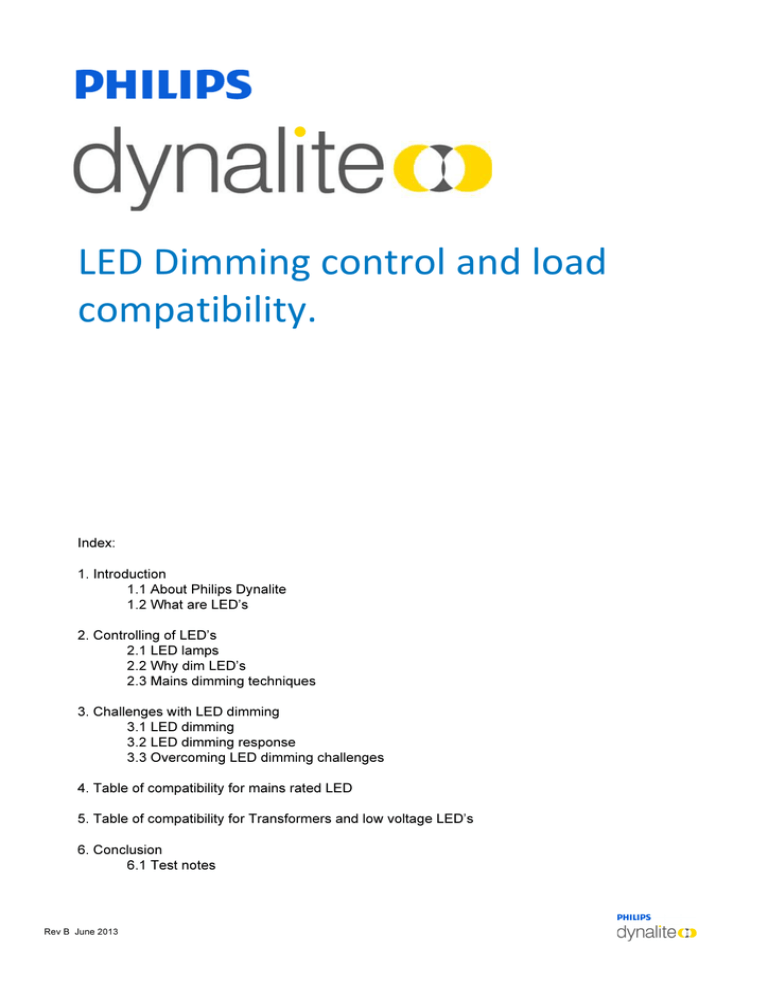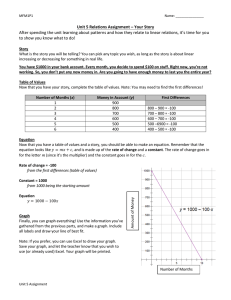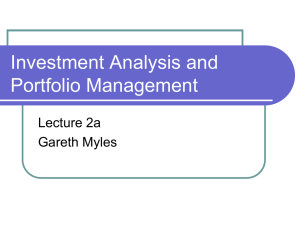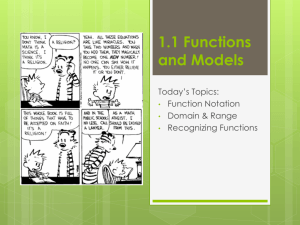
LED Dimming control and load
compatibility.
Index:
1. Introduction
1.1 About Philips Dynalite
1.2 What are LED’s
2. Controlling of LED’s
2.1 LED lamps
2.2 Why dim LED’s
2.3 Mains dimming techniques
3. Challenges with LED dimming
3.1 LED dimming
3.2 LED dimming response
3.3 Overcoming LED dimming challenges
4. Table of compatibility for mains rated LED
5. Table of compatibility for Transformers and low voltage LED’s
6. Conclusion
6.1 Test notes
Rev B June 2013
1.0 Introduction:
1.1 About Philips Dynalite
Philips Dynalite is a highly specialized company whose principal occupation is to provide
‘cutting edge’ solutions for lighting control. Our achievements have been recognized worldwide
and Philips Dynalite is generally the system of choice for projects involving integration with
third-party vendor’s equipment and for large-scale applications.
Philips Dynalite’s philosophy is to provide the best solution possible for each and every
project. This is the key to our success. Our considerable investment in Research &
Development ensures that we remain at the forefront of our industry. Our position as a world
leader in lighting management systems for the future is sustained through our total
commitment to innovation.
LEDs are quickly becoming the lamp of choice for many projects around the world due to their
high efficiency and expected life span. This emerging technology has brought many new
challenges to the lighting control market as LED lamps have different requirements and
response characteristics from previous generations of lighting lamps.
This document was created to better describe how a Philips Dynalite lighting control system
can be used to better manage LED lighting within any project.
1.2 What are LED lamps?
LED - Light Emitting Diode are electronic devices that produce light when an electrical current
is applied. Unlike incandescent lamps, LED’s don’t use heat to produce light which make them
much more efficient and have a longer operational life expectancy.
A single lamp may consist of multiple LED’s to produce the right level of light output. All LED’s
require supply at the correct DC voltage and current levels, this device is commonly called a
driver. Mains rated LED fittings have a driver built into the lamp, ensuring that the LED’s
receive the right current and voltage supply for correct operation.
Electronic symbol for LED
Rev B June 2013
2.0 Dimming LED’s
2.1 LED lamps
Not all LED lamps are dimmable, only lamps that have been specifically designed by the
manufacturer as dimmable may be dimmed. Attempting to dim a non-dimmable LED lamp or
using an incompatible dimming method will result in undesirable behaviour or complete lamp
failure. Dimmable lamps may only be compatible with certain dimming techniques. This paper
only discusses Leading edge and Trailing edge dimmable techniques but there are many other
methods that can be used such as DALI, 1-10, DMX and PWM, if compatible to the LED lamp
type.
2.2 Why dim LED lamps
As with any area in which artificial lighting is used, people like to adjust the lighting level to
meet their needs and create a more comfortable environment. Allowing the occupants of an
area to reduce the lighting level can help reduce glare when there is excessive lighting levels.
By reducing eye strain in office or school areas, occupants are more comfortable and better
able to focus on the task at hand, allowing for them to be more productive.
When dimming LED lamps, their power consumption is also reduced, producing further
running cost savings. A dimmed LED lamp also produces less heat which will help increase
their operation life and protects the investment an end-user has made into their LED lamps.
2.3 Mains Dimming techniques
Dimming of lighting through modifying the mains supply is a very common practice and has
been used in lighting control for many years. All AC mains supply comes in the form of a sine
wave, this wave is then modified to reduce the total output power. There are two types of
mains dimming techniques - Leading Edge (LE) and Trailing Edge (TE).
on
Leading Edge dimming is the most established technique in the
lighting control industry. In the example on the right, the dimming
system stops natural sine wave from rising and only at the required
time will it turn on the circuit and allow the supply to flow.
on
on
off
off
off
on
Trailing Edge dimming is relatively new style in comparison to Leading
Edge and is more compatible with electronic lighting loads. As TE is
more suited to electronic load types, it is more compatible with LED
loads. The dimming effect is achieved by letting the sine wave
naturally rise and then removing the supply at the required time to
produce the dimmed result.
on
on
off
off
off
Rev B June 2013
3.0 Challenges with LED dimming
3.1 LED dimming
When dimmed, LED lamps may become susceptible to a temporary or permanent flickering.
Care in selecting the right lighting controller for the desired LED lamp is important so the risk
of LED flickering can be reduced. Sources of LED lamp flicker can come from a range of
different locations and often at the same time, for example:
Mains supply instability
Noise on the mains supply or dimming system (e.g. mains control tones,
harmonic distortion, switching transients, etc)
Dimming system not loaded correctly
Too many or to few LED lamps are being used per lighting control channel
LED driver design
Dimmer level set too low
3.2 LED dimming response
LED lamps have very different response to dimming than previous generations of lighting
lamps. It is important to remember that the pre-set scenes of a lighting control system will
need to be adjusted if a project has upgraded to LED lamps.
LED lamps could also have a very different dimming curve to previous generations of lighting
lamps. A lighting control system will need to compensate for LED dimming site effects such as:
Dead travel. This is when adjusting the dimmer channel output seems to have no relative
effect to the LED lamp light output.
Popping on a LED lamp may require a minimum level before it is able to start producing light.
For some lamps this might be as high as 10%-15%.
3.3 Overcoming LED dimming challenges.
To help apply an LED lighting solution to any project, Philips Dynalite has developed a range
of products and useful tools for the correct selection of lighting controllers for LED lamps.
Correcting the load - Leading edge style dimmers, LED’s don’t provide enough draw current
for correct operation. This can produce a constant flicker and is sometimes called incorrect
latching. To provide the right kind of load, an active load device (DMAL120FR) can be
connected at any point of the lighting group.
Load compatibility table - Designing a correctly loaded lighting control system is now more
important than ever as LED lamps require the right selection of controllers. Sections 4 and 5
covers the compatibility of the different load controllers Philips Dynalite has available and how
best to load them.
Not all leading edge styles of dimming are compatible with LED lamps. Where a DMAL120FR
was required to provide corrected loading, it is shown on chart 4.
Rev B June 2013
4. Mains rated LED compatibility table
Type #
PHILI PS M A ST E R
GLO W LE D b ulb
7W E2 7
Trailing Edge Dimmers
DDTM102
standard dimming curve
Edited LED dimming Curve
DGTM402
standard dimming curve
Edited LED dimming Curve
DGTM105
standard dimming curve
Edited LED dimming Curve
DTE310 DTE1210
standard dimming curve
Edited LED dimming Curve
DGLEDM401
standard dimming curve
Edited LED dimming Curve
Rev B June 2013
%
PHILIPS M A ST E R LE D
C and le
3 W E14 2 70 0 K 2 2 0 V 240V B35 CL
PHILIP S M A ST ER
LED sp o t
8 W GU 10 KOD
No:
%
No:
%
No:
%
No:
1-100
2-13
5-100
5-100
5-100
1-8
1-8
1-8
1-100
1-100
1-100
2-30
2-30
2-30
1-95
1-95
1-95
2-12
2-12
2-12
1-100
2-13
5-100
1-8
1-100
2-30
1-95
2-12
5-100
1-8
1-100
2-30
1-95
2-12
5-100
1-8
1-100
2-30
1-95
2-12
5-100
1-15
1-100
5-100
1-15
1-100
5-100
1-19
5-100
1-19
1-100
5-100
1-12
1-100
1-100
1-100
1-100
2-13
1-26
2-33
5-100
1-100
1-100
1-100
1-100
1-100
1-100
1-100
1-33
5-100
2-66*
2-66*
%
No:
1-100
1-26
1-100
1-26
1-100
1-15
1-95
2-12
1-100
1-15
1-100
1-13
1-95
1-28
1-95
1-28
1-95
1-28
1-95
1-28
1-95
3-28
1-95
3-28
1-95
3-28
1-95
3-28
1-95
2-53
1-95
2-53
1-95
2-53
1-95
2-53
1-95
2-53
1-95
2-53
1-95
2-53
1-95
2-53
1-95
2-53
1-95
2-53
1-95
2-53
1-95
2-53
1-95
2-53
1-95
2-53
1-40
1-65
1-65
1-65
1-82
1-100
1-82*
%
No:
%
No:
5-100
1-15
1-82*
1-82*
15-100
1-48
25-100
1-38
1-15
1-100
1-100
1-100
1-100
1-100
1-100
1-26
2-33
1-33
2-66
2-66
2-66
1-95
2-53
1-95
2-53*
1-95
2-53*
1-95
2-53*
1-95
2-53*
1-95
2-53*
1-95
2-53*
1-100
2-66*
%
No:
%
No:
1-95
1-14
1-95
1-100
1-100
2-66
2-66*
2-66*
1-100
1-26
1-100
1-26
1-14
1-95
1-22
1-95
1-48
1-95
1-14
1-53
1-100
1-140
1-38
1-100
2-13
1-13
1-38
1-100
1-15
1-100
1-95
5-100
25-100
1-100
2-12
1-95
1-38
1-15
2-12
1-95
1-13
1-38
5-100
1-95
1-13
5-100
1-48
2-13
1-95
5-100
25-100
1-100
1-95
1-38
1-48
2-13
1-36
1-38
5-100
1-100
1-27
5-100
1-28
No:
1-15
1-15
1-15
1-95
5-100
5-100
%
1-100
1-100
1-100
1-36
1-38
1-100
No:
2-12
2-12
2-12
1-27
1-38
1-100
%
1-95
1-95
1-95
1-23
1-38
P HILIP S M A ST ER
LE D sp o t
6 - 50 W GU 10
No:
1-95
5-100
1-40
1-26
1-100
%
PHILIPS M A ST ER
LED sp o t
8 W GU 10 D IM T ON E
1-95
5-100
5-100
1-100
1-100
1-100
2-66
2-66
1-100
1-100
2-66
2-66*
1-100
1-19
2-66
1-100
1-100
1-19
3-32
PHILIPS M A ST E R
LED sp o t
7W G U 10
1-100
1-100
1-95
1-23
1-95
1-27
1-95
1-27
1-95
2-53
1-95
2-53*
1-95
2-53*
1-95
2-53*
1-30
%
PHILIP S M A ST ER LED
PA R 3 8 18 W E 2 7
No:
%
No:
10-95
1-8
10-95
10-95
10-95
2-5
2-5
2-5
10-95
1-8
10-95
10-95
1-8
1-15
10-95
2-5
10-95
2-5
10-95
2-5
10-95
2-10
10-95
2-10
10-95
2-12
2-12
1-100
1-38
10-95
1-19
10-95
1-100
1-23
10-95
1-12
10-95
1-8
10-95
1-12
1-100
1-38
10-95
1-19
10-95
1-12
1-100
1-38
10-95
1-19
10-95
1-12
1-100
1-76
10-95
1-38
10-95
2-25
1-100
1-76
10-95
1-38
10-95
2-25
1-100
1-76
10-95
1-38
10-95
2-25
1-100
1-76
10-95
1-38
10-95
2-25
1-100
1-76*
10-95
1-38*
10-95
2-25*
1-100
1-76*
10-95
1-38*
10-95
2-25*
1-95
2-53*
1-95
2-53*
1-95
2-53*
1-100
1-76*
10-95
1-38*
10-95
2-25*
%
No:
%
No:
%
No:
%
No:
1-95
1-14
1-100
1-24
1-100
1-24
1-95
1-14
1-95
1-22
1-95
1-48
1-95
1-14
1-40
1-48
1-26
1-100
P HILIPS M A S T ER LED
PA R 3 0 S 12 W E2 7
1-100
1-36
1-100
1-81
1-100
1-24
KEY
Dimmable, with x to y lamps up to a max of 10% of the max dimmer load
The majority of configurations show undesirable dimming behavior
Configuration not tested
Leading Edge Dimmers
DDLE802
DDLE802 + DMAL120FR
DDMC802 + DDLM102
DDMC802 + DDLM102 + DMAL120FR
DDMC802GL + DGLM402
DDMC802GL + DGLM402 + DMAL120FR
DDMC802 + DDLM104
DDMC802 + DDLM104 + DMAL120FR
DDMC802GL + DGLM105
DDMC802GL + DGLM105 + DMAL120FR
DLE1203
DLE1203 + DMAL120FR
DLE405
DLE405 + DMAL120FR
DLE1205
DLE1205 + DMAL120FR
DLE410
DLE410 + DMAL120FR
DMC810GL
DMC810GL + DMAL120FR
DLE1210GL
DLE1210GL + DMAL120FR
DLE1210
DLE1210 + DMAL120FR
DLE120-S
DLE120-S + DMAL120FR
DLE220-S
DLE220-S + DMAL120FR
DLE1220GL-S
DLE1220GL-S + DMAL120FR
PHI LIPS M A ST ER
LED b ulb
12 - 6 0 W B 2 2 2 70 0 K
230V A60
NOTES:
* - indicates higher number
possible, subject to the installation
check
Please contact Philips Dynalite for
more information.
5. Low voltage LED and transformer
PHILIPS MASTER LEDSpot MR16 Dim 7W 12VAC
Osram ET-REDBACK 60VA/230-240 (20-60W)
Dimming range
PHILIPS MASTER LEDSpot MR16 Dim 7W 12VAC
Philips ET-S 60VA 220-240V
Number of
Number of Max number
lamps per transformers of lamps per
transformer per channel
channel
Dimming range
PHILIPS MASTER LEDSpot MR16 Dim 10W 12VAC
Osram ET-REDBACK 60VA/230-240 (20-60W)
Number of
Number of Max number
lamps per transformers of lamps per
transformer per channel
channel
Dimming range
Number of
Number of Max number
lamps per transformers of lamps per
transformer per channel
channel
Leading edge dimmers
DDLE802 &
DGLM402
DGLM402
DDLM104
DGLM105
DLE1203
DLE405
DLE1205
DLE410
DMC810GL
DLE1210GL
DLE1210
DLE120-S
DLE220-S
DLE1220GL-S
10%-100%
10%-100%
10%-100%
10%-100%
10%-100%
10%-100%
10%-100%
10%-100%
10%-100%
10%-100%
10%-100%
10%-100%
10%-100%
10%-100%
1-2
1-2
1-2
1-2
1-2
1-2
1-2
1-2
1-2
1-2
1-2
1-2
1-2
1-2
2-6
2-6
2-13
2-16
2-9
2-16
3-16
5-32
5-32
5-32
5-32
5-32*
5-32*
5-32*
12
12
26
32
18
32
32
64
64
64
64
64*
64*
64*
10%-100%
10%-100%
10%-100%
10%-100%
10%-100%
10%-100%
10%-100%
10%-100%
10%-100%
10%-100%
10%-100%
10%-100%
10%-100%
10%-100%
1-2
1-2
1-2
1-2
1-2
1-2
1-2
1-2
1-2
1-2
1-2
1-2
1-2
1-2
2-6
2-6
2-13
2-16
2-9
2-16
3-16
5-32
5-32
5-32
5-32
5-32*
5-32*
5-32*
12
12
26
32
18
32
32
64
64
64
64
64*
64*
64*
10%-100%
10%-100%
15%-100%
15%-100%
15%-100%
15%-100%
15%-100%
15%-100%
15%-100%
15%-100%
15%-100%
15%-100%
15%-100%
15%-100%
1-2
1-2
1-2
1-2
1-2
1-2
1-2
1-2
1-2
1-2
1-2
1-2
1-2
1-2
2-4
2-4
2-9
6-11
2-7
2-11
3-11
5-23
5-23
5-23
3-23
2-23*
5-23*
5-23*
8
8
18
22
14
22
22
46
46
46
46
46*
46*
46*
Trailing edge dimmers
DDTM102
DGTM402
DGTM105
DTE310
DTE1210
DGLEDM401
10%-100%
10%-100%
7%-100%
1-2
1-2
1-2
1-13
1-13
1-25
26
26
50
5%-100%
5%-100%
5%-100%
1-2
1-2
1-2
1-13
1-13
1-25
26
26
50
10%-100%
10%-100%
10%-100%
1-2
1-2
1-2
1-9
1-9
1-17
18
18
34
7%-100%
20%-100%
1-2
1-2
1-41
1-13
82
26
7%-100%
20%-100%
1-2
1-2
1-41
1-13
82
26
10%-100%
20%-100%
1-2
1-2
1-29
1-9
58
18
KEY
Dimmable, with x to y lamps up to a max of 10% of the max dimmer load
Lamps are dimmable across full dimming range, but exhibit flickering at a single distinct position in the range (usually 80% light level point)
The majority of configurations show undesirable dimming behavior
Configuration not tested
Rev B June 2013
5. Low voltage LED and transformer
PHILIPS AR111 (10W)**
Philips ET-S 60VA 220-240V
PHILIPS MASTER LEDSpot MR16 Dim 10W 12VAC
Philips ET-S 60VA 220-240V
Dimming range
Number of lamps per
transformer
Number of
transformers per
channel
PHILIPS AR111 (15W)
Philips ET-S 60VA 220-240V
Number of
Number of lamps per
Max number of lamps
transformers per
transformer
per channel
channel
Max number of lamps
per channel
Dimming range
2-4
2-4
2-9
6-11
2-7
2-11
3-11
5-23
5-23
5-23
3-23
2-23*
5-23*
5-23*
8
8
18
22
14
22
22
46
46
46
46
46*
46*
46*
15%-100%
15%-100%
15%-100%
15%-100%
15%-100%
15%-100%
15%-100%
15%-100%
15%-100%
15%-100%
15%-100%
15%-100%
15%-100%
15%-100%
1-2
1-2
1-2
1-2
1-2
1-2
1-2
1-2
1-2
1-2
1-2
1-2
1-2
1-2
2-4
2-4
2-9
6-11
2-7
2-11
3-11
5-23
5-23
5-23
3-23
2-23*
5-23*
5-23*
Dimming range
Number of lamps per
transformer
Number of
transformers per
channel
8
8
18
22
14
22
22
46
46
46
46
46*
46*
46*
5%-100%
5%-100%
5%-100%
5%-100%
5%-100%
5%-100%
1
1
1
1
1
1
5-5
5-5
5-11
5-14
1-8
5-14
5%-100%
5%-100%
5%-100%
5%-100%
5%-100%
5%-100%
1
1
1
1
1
1
2-28
2-28
2-28
1-56
2-56
1-56
Leading edge dimmers
DDLE802 & DGLM402
15%-100%
15%-100%
15%-100%
15%-100%
15%-100%
15%-100%
15%-100%
15%-100%
15%-100%
15%-100%
15%-100%
15%-100%
15%-100%
15%-100%
DGLM402
DDLM104
DGLM105
DLE1203
DLE405
DLE1205
DLE410
DMC810GL
DLE1210GL
DLE1210
DLE120-S
DLE220-S
DLE1220GL-S
1-2
1-2
1-2
1-2
1-2
1-2
1-2
1-2
1-2
1-2
1-2
1-2
1-2
1-2
Trailing edge dimmers
DDTM102
DGTM402
DGTM105
DTE310 DTE1210
DGLEDM401
7%-100%
7%-100%
7%-100%
1-2
1-2
1-2
1-9
1-9
1-17
18
18
34
5%-100%
5%-100%
5%-100%
1-2
1-2
1-2
1-9
1-9
1-17
18
18
34
5%-100%
5%-100%
5%-100%
1
1
1
1-11
1-11
1-20
5%-100%
20%-100%
1-2
1-2
1-29
1-9
58
18
7%-100%
20%-100%
1-2
1-2
1-29
1-9
58
18
7%-100%
20%-100%
1
1
1-35
1-5
KEY
Dimmable, with x to y lamps up to a max of 10% of the max dimmer load
Lamps are dimmable across full dimming range, but exhibit flickering at a single distinct position in the range (usually 80% light level point)
The majority of configurations show undesirable dimming behavior
Configuration not tested
Rev B June 2013
6.0 Conclusions
Despite the many challenges that LED control presents, the running cost benefits make it a
worthwhile goal.
Philips Dynalite is committed to continuous testing different LED types with all of its load
controller options to provide the best and most up-to-date information possible. If there is an
LED that has not been tested that you would like to use on a upcoming project, please send a
request to the following email address. dynalite.info@philips.com
6.1 Testing notes
All percentages shown are from the Philips Dynalite commissioning software, dimmers
channel output level.
Local mains quality may affect dimming performance as it may change at different periods
during a day and also over time due to variable levels and types of loads on site and in nearby
buildings. No assurance can be provided about these factors, so a general recommendation is
to perform a test on site prior to installing the LED lamps.
Before re-lamping a project site from incandescent fittings to LED fittings it is highly
recommended that a test be performed on a single lighting group. To conducted a
comprehensive test all lamps on an existing light group should be changed over to the
nominated LED fittings which are going to be used and observed over a 48 hour period to
determine if there are any site related issues regarding lamp performance.
Local project supply noise or main instability were not factored into testing. All tests were
conducted on stable mains supply.
Philips Dynalite does not accept any liability arising from the recommendations and test results presented in this report.
They are for indicative purposes only and subject to changes in lamp and dimmer design, with no notification provided.
Rev B June 2013
Disclaimer
These instructions have been prepared by Philips Dynalite and provide information on Philips Dynalite products
for use by registered owners. Some information may become superseded through changes to the law and as a
result of evolving technology and industry practices.
Any reference to non- Philips Dynalite products or web links does not constitute an endorsement of those
products or services
Copyright
© 2012 Dynalite manufactured by WMGD Pty Ltd (ABN 33 097 246 921). All rights reserved. Not to be
reproduced without permission. The Dynalite logo is a registered trademark of WMGD Pty Ltd. Philips Dynalite
is a highly specialized company whose principal occupation is to provide ‘cutting edge’ solutions for lighting
control.
Rev B June 2013



